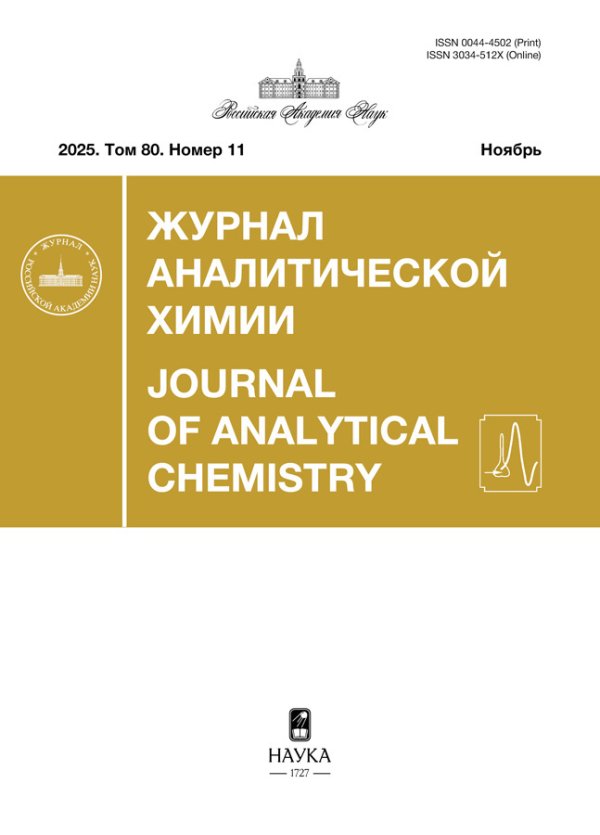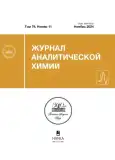Recognition of objects of similar composition and determination of fluoroquinolones using the reaction of carbocyanine Cy7-hydrazine with 4-dimethylaminobenzaldehyde
- Authors: Orekhov V.S.1, Skorobogatov Е.V.1, Beklemishev М.K.1
-
Affiliations:
- Lomonosov Moscow State University
- Issue: Vol 79, No 11 (2024)
- Pages: 1172-1184
- Section: ORIGINAL ARTICLES
- Submitted: 16.06.2025
- URL: https://vestnik.nvsu.ru/0044-4502/article/view/684627
- DOI: https://doi.org/10.31857/S0044450224110043
- EDN: https://elibrary.ru/sxbpld
- ID: 684627
Cite item
Abstract
The study is devoted to the development of a fluorimetric version of the “fingerprint” method based on conducting indicator reactions in the presence of an object. Observing the reaction over time increases the amount of information received compared to the static version, which allows for improved object recognition, as well as quantitative analysis. As an indicator reaction, it is proposed to use the interaction of a commercial carbocyanine dye with 4-dimethylaminobenzaldehyde, which leads to a decrease in the intensity of fluorescence and a change in light absorption over time. Three fluoroquinolones (moxifloxacin, levofloxacin and ofloxacin) selectively alter the signal at concentrations ≥1 µm; other medicinal substances, including other fluoroquinolones, do not interfere. Ofloxacin was determined in human urine samples at different times after taking the drug. The possibility of using the same indicator reaction for object recognition is shown on the example of samples of apple juices, soil extracts and meat of varying degrees of freshness. Chemometrics methods, including linear discriminant analysis, were used to process the data. 15 apple juices were discriminated with 97% accuracy, 10 apple juices produced in 2022 and 2023 (94%), 10 soil samples (99%), and the possibility of determining the freshness of meat was shown using the example of five samples.
Keywords
Full Text
About the authors
V. S. Orekhov
Lomonosov Moscow State University
Email: skoregy@gmail.com
Russian Federation, 1, Leninskie Gory, Moscow, 119991
Е. V. Skorobogatov
Lomonosov Moscow State University
Author for correspondence.
Email: skoregy@gmail.com
Russian Federation, 1, Leninskie Gory, Moscow, 119991
М. K. Beklemishev
Lomonosov Moscow State University
Email: skoregy@gmail.com
Russian Federation, 1, Leninskie Gory, Moscow, 119991
References
- Curtman L.J., Rothberg P. Application of the “glow reaction” to the qualitative detection of the platinum metals // J. Am. Chem. Soc. 1911. V. 33. P. 718. https://doi.org/10.1021/ja02218a010
- Feigl F., Fränkel E. Beiträge zur analytischen verwertung von katalysen-reaktionen // Ber. Dtsch. Chem. Ges. 1932. V. 65. P. 539. https://doi.org/10.1002/cber.19320650407
- Szebellédy L., Bártfay M. Mangannaehweis mittels katalyse // Z. Anal. Chem. 1936. V. 106. P. 408. https://doi.org/10.1007/BF01376681
- Яцимирский К.Б. Кинетические методы анализа. М.: Химия. 1967. 200 с.
- Дружинин А.А. Кинетические методы анализа органических соединений // Журн. Всес. хим. о-ва им. Менделеева. 1970. Т. 15. С. 529.
- Crouch S.R., Scheeline A., Kirkor E.S. Kinetic determinations and some kinetic aspects of analytical chemistry // Anal. Chem. 2000. V. 72. P. 53. https://doi.org/10.1021/a1000004b
- Palleschi G. Kinetics in analytical chemistry // Anal. Bioanal. Chem. 2005. V. 381 P. 1321. https://doi.org/10.1007/s00216-005-3128-1
- Муштакова С.П. Теория действия и применение органических редокс-реагентов ряда дифениламина в спектрофотометрическом анализе: Дис. … докт. хим. наук. Саратов, 1987. 400 с.
- Беклемишев М.К. Новые индикаторные системы в кинетических методах анализа. Сорбционно-кинетический метод. Дис. … докт. хим. наук. М.: МГУ, 2011. 367 с.
- Шеховцова Т.Н. Ферментативные методы анализа: Определение эффекторов гидролаз и оксидоредуктаз. Дис. … докт. хим. наук. М.: МГУ, 1996. 335 c.
- Веселова И.А. Оптические сенсорные системы на основе пероксидазы для определения органических биологически активных веществ. Дис. … докт. хим. наук. М.: МГУ, 2018. 272 c.
- Dickinson T., White J., Kauer J., Walt D.R. A chemical-detecting system based on a cross-reactive optical sensor array // Nature. 1996. V. 382. P. 697. https://doi.org/10.1038/382697a0
- Anzenbacher P., Palacios M.A. Array-based sensors / Chemosensors: Principles, Strategies, and Applications. 1st Ed. / Eds. Wang B., Anslyn E.V. John Wiley & Sons, 2011. 544 p.
- Sádecká J., Tóthová J. Fluorescence spectroscopy and chemometrics in the food classification – a review // Czech. J. Food Sci. 2007. V. 25. P. 159. http://doi.org/10.17221/687-CJFS
- Askim J.R., Mahmoudia M., Suslick K.S. Optical sensor arrays for chemical sensing: The optoelectronic nose // Chem. Soc. Rev. 2013. V. 42. P. 8649. https://doi.org/10.1039/C3CS60179J
- Власов Ю.Г., Легин А.В., Рудницкая А.М. Электронный язык: химические сенсорные системы для анализа водных сред // Журн. общ. химии. 2008. Т. 78. С. 2532. https://doi.org/10.1134/S1070363208120335. (Vlasov Y.G., Legin A.V., Rudnitskaya A.M. Electronic tongue: Chemical sensor systems for analysis of aquatic media // Russ. J. Gen. Chem. 2008. V. 78. P. 2532. https://doi.org/10.1134/S1070363208120335)
- Yang J., Lu Y., Ao L., Wang F., Jing W., Zhang S., Liu Y. Colorimetric sensor array for proteins discrimination based on the tunable peroxidase-like activity of AuNPs-DNA conjugates // Sens. Actuators B. 2017. V. 245. P. 66. https://doi.org/10.1016/j.snb.2017.01.119
- Shariati-Ra M., Mozaffari Y. Water discrimination based on the kinetic variations of AgNP spectrum // RSC Adv. 2020. V. 10. P. 34459. http://doi.org/10.1039/D0RA06000C
- Liu L., Zhang L., Liang Y. A simple visual strategy for protein detection based on oxidase-like activity of silver nanoparticles // Food Anal. Methods. 2021. V. 14. P. 1852. https://doi.org/10.1007/s12161-021-02011-6
- Wang F., Na N., Ouyang J. Particle-in-a-frame gold nanomaterials with an interior nanogap-based sensor array for versatile analyte detection // Chem. Commun. 2021. V. 57. P. 4520. https://doi.org/10.1039/D1CC01094H
- Wang L., Hu Z., Wu S., Pan J., Xu X., Niu X. A peroxidase-mimicking Zr-based MOF colorimetric sensing array to quantify and discriminate phosphorylated proteins // Anal. Chim. Acta. 2020. V. 1121. P. 26. https://doi.org/10.1016/j.aca.2020.04.073
- Степанова И.А., Лебедева А.Н., Шик А.В., Скоробогатов Е.В., Беклемишев М.К. Распознавание и определение сульфаниламидов методом ближней ИК-флуориметрии по их влиянию на скорость каталитического окисления карбоцианинового красителя пероксидом водорода // Журн. аналит. химии. 2021. Т. 76. С. 1397. https://doi.org/10.1134/S1061934821120121. (Stepanova I.A., Lebedeva A.N., Shik A.V., Skorobogatov E.V., Beklemishev M.K. Recognition and determination of sulfonamides by near-IR fluorimetry using their effect on the rate of the catalytic oxidation of a carbocyanine dye by hydrogen peroxide // J. Anal. Chem. 2021. V. 76. P. 1397. https://doi.org/10.1134/S1061934821120121)
- Shik A.V., Stepanova I.A., Doroshenko I.A., Podrugina T.A., Beklemishev M.K. Carbocyanine-based fluorescent and colorimetric sensor array for the discrimination of medicinal compounds // Chemosensors. 2022. V. 10. P. 88. https://doi.org/10.3390/chemosensors10020088
- Shik A.V., Skorobogatov E.V., Bliznyuk U.A., Chernyaev A.P., Avdyukhina V.M., Borschegovskaya P.Y., et al. Estimation of doses absorbed by potato tubers under electron beam or X-ray irradiation using an optical fingerprinting strategy // Food Chem. 2023. V. 414. Article 135668. https://doi.org/10.1016/j.foodchem.2023.135668
- Shik A.V., Stepanova I.A., Doroshenko I.A., Podrugina T.A., Beklemishev M.K. Carbocyanine-based optical sensor array for the discrimination of proteins and rennet samples using hypochlorite oxidation // Sensors. 2023. V. 23. P. 4299. https://doi.org/10.3390/s23094299
- Pypin A.A., Shik A.V., Stepanova I.A., Doroshenko I.A., Podrugina T.A., Beklemishev M.K. A reaction-based optical fingerprinting strategy for the recognition of fat-soluble samples: Discrimination of motor oils // Sensors. 2023. V. 23. P. 7682. https://doi.org/10.3390/s23187682
- Shik A.V., Sobolev P.V., Zubritskaya Y.V., Baytler M.O., Stepanova I.A., Chernyaev A.P., et al. Rapid testing of irradiation dose in beef and potatoes by reaction-based optical sensing technique // J. Food Compos. Anal. 2024. V. 127. Article 105946. https://doi.org/10.1016/j.jfca.2023.105946
- Liu C., Qian Z., Chen Z. A dual channel fluorescence tongue for catechin recognition based on the MnO2 nanorods–Amplex Red–o-phenylenediamine reaction system // Anal. Methods. 2023. V. 15. P. 6476. https://doi.org/10.1039/D3AY01748F
- Jing W., Shi Q., Zheng M., Yang Y., Qiang S., Jia Z., et al. Smartphone-assisted nanozyme sensor array constructed based on reaction kinetics for the discrimination and identification of phenolic compounds // Anal. Chim. Acta. 2024. V. 1287. Article 342133. https://doi.org/10.1016/j.aca.2023.342133
- Pargari M., Marahel F., Goodajdar B.M. Kinetic spectrophotometric method and neural network model application for the quantitation of epinephrine by starch-capped AgNPs sensor in blood and urine // J. Anal. Chem. 2022. V. 77. P. 484. https://doi.org/10.1134/S1061934822040074
- Захаренкова С.А., Лебедева М.И., Лебедева А.Н., Дорошенко И.А., Кривцов Г.Г., Ежов А.А., Подругина Т.А., Беклемишев М.К. Средства визуализации доставки лекарственных веществ с использованием анионированных хитозанов / Сб. тезисов 5-й Российской конференции по медицинской химии с международным участием “МедХим-Россия 2021”. Волгоградский государственный медицинский университет, 2021. С. 432. https://doi.org/10.19163/MedChemRussia20212021-432
- XLSTAT-Pro. User’s manual. Addinsoft, 2003. P. 124. https://www.xlstat.com/en/solutions/features/discriminant-analysis-da (20.04.2024).
Supplementary files

















